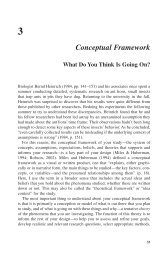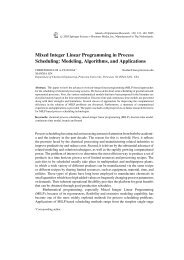R7.1 Polymerization
R7.1 Polymerization
R7.1 Polymerization
You also want an ePaper? Increase the reach of your titles
YUMPU automatically turns print PDFs into web optimized ePapers that Google loves.
369<br />
Chap.<br />
Now that we can determine the monomer concentration as a function of<br />
time, we will focus on determining the distribution of dead polymer, Pj.<br />
The<br />
concentrations of dead polymer and the molecular weight distribution can be<br />
derived in the following manner. 5 The probability of propagation is<br />
Simplifying<br />
(<strong>R7.1</strong>-22)<br />
In the absence of chain transfer, the monomer concentration, M,<br />
can be determined<br />
from Equation (<strong>R7.1</strong>-22) and concentration of initiator, I2,<br />
from Equation<br />
(<strong>R7.1</strong>-19). Consequently we have � as a function of time. We now set<br />
to use in the Flory distribution.<br />
It can be shown that in the absence of termination by combination, the<br />
mole fractions yj<br />
and weight fraction wj<br />
are exactly the same as those for step<br />
polymerization. That is, we can determine the dead polymer concentrations<br />
and molecular weight distribution of dead polymer in free radial polymerization<br />
for the Flory distributions. For example, the concentration of dead polymer<br />
of chain length n is<br />
⎛ � ⎞<br />
where ⎜ Pn is the total dead polymer concentration and<br />
⎝�⎟ ⎠<br />
(<strong>R7.1</strong>-6)<br />
which is the same as the mole fraction obtained in step polymerization, i.e.<br />
Equation (<strong>R7.1</strong>-6).<br />
If the termination is only by disproportionation, the dead polymer Pj<br />
will<br />
have the same distribution as the live polymer .<br />
5<br />
n�2<br />
Rate of propagation<br />
� � ---------------------------------------------------------------------------------------------------- � --------------<br />
Rate of propagation � Rate of termination �<br />
k p MR �<br />
�<br />
k p MR� ks SR� km MR� kcCR� kt R� ( ) 2<br />
� -----------------------------------------------------------------------------------------------------------<br />
� � � �<br />
k p M<br />
� � -----------------------------------------------------------------------------------------------<br />
� � � � ( )<br />
k p M k m M k cC k s S 2k t k o f I 2<br />
� � p<br />
⎛ � ⎞ ⎛ � ⎞<br />
Pn � yn ⎜ P � j⎟<br />
� ⎜ P j<br />
⎝ ⎠ ⎝�⎟ ( 1 � p)<br />
⎠<br />
j�2<br />
j�2<br />
yn ( 1 � p)pn�1<br />
�<br />
E. J. Schork, P. B. Deshpande, and K. W. Leffew, Control of <strong>Polymerization</strong> Reactor<br />
(New York: Marcel Dekker, 1993).<br />
R<br />
j<br />
pn�1<br />
r p<br />
r p rt
















